Brad Ives, associate vice chancellor for campus enterprises, said the concept of water neutrality lacks a concrete definition.
“We think we need to set some standards about water neutrality, and that there are going to be different levels of water neutrality, and we wanted to find those,” he said. “That’s part of what this effort is about.”
Sustainability Office Director Cindy Shea said the University has achieved a near balance between the water it uses and the natural water cycle through a series of recent environmental upgrades.
“The ways that we’ve achieved that in recent years are to invest in water efficiency, to capture and harvest rainwater for reuse and to use reclaimed water instead of drinking water,” she said.
Ives said by some standards, the University already met the water neutrality goal.
“For example, right now we can say that we are, in fact, water neutral, based on the amount of rainfall that falls on the campus every year is more than sufficient for the amount of drinking water that we use,” he said.
Shea said further analytics are necessary before the University can determine for certain which water neutrality standards have been met.
Nikki Behnke, co-president of A Drink for Tomorrow at UNC, a clean water advocacy group run by students, said water neutrality should be defined by an institution’s impact on the water cycle.




